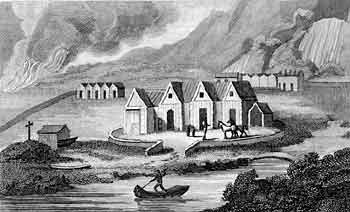Observing and Recording
Those who travelled to Iceland in the 19th century had many different objectives in mind - some were in search of cultural links with Scotland and North Britain, others were seeking adventure and new experience. The urge to observe and record was a shared one, which has left many vivid accounts of the country and its changing society.
Facts and figures about Iceland's economy and society were collected by these early travellers. Their records sometimes took the form of statistics - details for instance about the imports and exports of Iceland were provided by Sir George Steuart Mackenzie in Travels in the Island of Iceland (1812).

An Icelandic House from Travels in Iceland, Ólafsson and Pálsson (1805)
Sir Richard Burton (1821-1890), better known for his African travels and works of translation, spent the summer of 1872 in Iceland. He made detailed observations on agriculture and rural society. His recollections, in Ultima Thule:Or, A Summer in Iceland (1875), include a table listing families and their servants by occupational categories.

An Icelandic Home from Iceland: its volcanoes, geysers, and glaciers, Forbes (1829-1876)
Although the illustrations in travel books tend to concentrate on dramatic scenery, they also portray Icelandic homes and the rural economy. Charles Stuart Forbes (1829-1876) in Iceland: its volcanoes, geysers, and glaciers (1860) depicts the interior of a modest house, with the family listening to a story being read.
Different perspectives on domestic life are found in the floor plan of a farm house, published in Sabine Baring-Gould's Iceland, Its Scenes and Sagas (1863), and in the image of a homestead in its rural setting, recorded by Ólafsson and Pálsson (Travels in Iceland, 1805).

Plan and Elevation of Icelandic farm from Iceland, Its Scenes and Sagas, Baring-Gould (1863)
Next: Northern Tongues